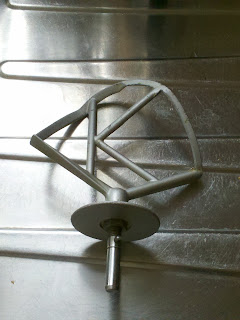'Tis the season to be... audited
originally posted on one of my several now defunct blogs, called On Engineering, on 13th December 2012
December. Time of cheer and good will to all colleagues, rushing for presents, updating projects, Glühwein, clearing out inboxes, eating far too much chocolate, finalising reports and…
And getting audited.
Yes, we were audited this week and one of my projects was in the spotlight. It was all going swimmingly until the auditor heat-seekingly locked on to one particular thread of my project that wasn’t really parcelled up and tied with string - ironically enough, the DFMEA.
Being shown up as lax in my own project was certainly embarrassing, one of those half-expected shocks to the system; I felt a bit like a child hoping rather than expecting not to be found out about those stolen chocolates. I was hoping rather than expecting to be able to skim over that the incomplete DFMEA (structure present and correct, values not), knowing that it was a weakness without really having polished it off beforehand. I was found out, and rightly so: that’s the reason audits happen.
We were marked down for it, of course, and I’ll have to get things back into shape sharpish.
Reading those words of mine just above (“that’s the reason audits happen”), I surprise myself with how true they ring.
Have I finally come to accept them? And if so, how do I accept them? Gladly, or grudgingly?
{Audits stand…} for engineering by checklist, for doing rather than thinking, for rewarding completeness rather than innovation
For years I’ve harboured a deep suspicion, a dislike of audits and what they stood for. For me, they stood for engineering by checklist, for doing rather than thinking, for rewarding completeness rather than innovation and - for the vast majority of my auditing experience - huge cleaning up operations for close to zero benefit.
When is something that is good enough not good enough? When it’s being audited.
I have experienced both sides of auditing; I have audited and have been audited. From being part of an auditing team, working alongside quite an enlightened auditing colleague, I understand that the mindset of an auditor should be a positive one, aiming to help the subject improve by pointing out the weaknesses and working on agreements to correct those weaknesses before they lead to genuine failures. This mindset should match that of the auditee. When both see the positives that can come out of the (like FMEAs) negative messages, then things are heading in the right direction.
Nevertheless, audits are a not insignificant burden on everybody involved. Couldn’t we just wish audits, along with PPAPs, away?
Well, not easily: auditing is a multi-billion dollar industry in its own right, valid across a whole spectrum of industries, and it’s a difficult edifice to start chipping away at. But even so: wouldn’t our engineering lives be so much more enjoyable without them?
Initially, yes - they would be. We would be freed up again to design and develop as we know best: we know what our products are supposed to achieve and how to get them to that stage, even if not every Excel list has been filled out to the n’th degree en route. We could potentially become more like Google, where “…in the innovative and fast-paced world that [the Google developer] lives in, you get what you get.” (From How Google Tests Software)
We would have more money and time to spend on D&D, too, not having to pay those auditing firms their crust or having to spend all of those man-hours preparing “just in case it’s audited”.
But let’s look at it another way. Let’s say we want to start using a lower-cost supplier, more than likely in the old Eastern Bloc or somewhere (usually very large) in Asia. What are these companies like? Can we entrust our intellectual property, our quality and our good name to them? What better starting point could there be than searching for a certificate alongside customer references? (well, it’s true that there are differences in auditing rigour in China, even amongst the financial big four, as The Economist magazine writes)
Audits cannot guarantee a good name, nor necessarily a good engineering company: there are firms with certificates on their walls that I wouldn’t wish on our fiercest competitors. In the same way that financial audits have missed gaping holes where the subjects have been playing the game better than they have - like Lehman Brothers, Enron and, it seems, Autonomy - quality audits can almost be guaranteed to miss something big from time to time.
Even the auditors themselves get themselves in a muddle - our December date with auditing destiny came about when the auditing company missed a submission deadline. This swiftly became our problem when our certificates were due to expire and our emergency re-audit date last December became our annual date. Thanks, we appreciate it!
So, what are audits good for, then? Qui bono? For starters, audits are a reassuringly expensive starting hurdle to business: my industry - automotive - and many others have gotten themselves into a standardised twist, whereby an ISO / TS 16949 certificate is a prerequisite for supplying to an OEM. It’s a pay-to-play move giving potential customers a guide that the company won’t royally mess things up when they start a supply relationship.
Audits also place a burden of duty and therefore responsibility on companies and their employees – from management right down to lab technicians – to get things right. Not only to “get things right” but also to “design things right”. This applies both to the product itself and to the process of how you get the product into a customer’s hands. Ideally, an audit should be imperceptible other than having to make some coffee for a visitor and answering a few questions. Why should you have to prepare if you are living the systems that you have declared fit for your own purpose?
Umm, too much other stuff to do, perhaps? Not enough time to focus? Not enough mental energy left for yet another list-trawl?
Well, if audits and all the stuff that we have to prepare for them really are a burden, then - again, ideally - they should become the impulse for genuine improvements in the way we work, in the way we communicate and collaborate. All of that form-filling, report-writing and change log management should have a genuine purpose, even if it is occasionally completed in the grudging spirit of passing an audit. All of these items are part of the company’s index of information. When we change and update those forms, we are changing history, improving it. It’s about creating a legacy, hopefully one of that will make sense of our successors' past.
The one thing that can make audits bearable is for everybody involved to treat it as a human thing - checks and balances are inevitably required whenever human endeavour is at work, so go with it. Let the auditors ask the good questions and let them discover how you work - even I with my DFMEA fail this time around will have shown that overall we’re working well and are going in the right direction. So, I’ll take that “nonconformity” hit and try to improve on managing my projects along with managing everything else, and let’s see if we can find some mental space to put to use on streamlining our work so we can do better next time.
And so back to my initial question: do I accept audits gladly or grudgingly? Well, of course it’s still the latter, but at least it means that I aim to keep them as low profile as possible: for that, though, I’ll need the support of my management – and I can assure you that the audit result was a wake-up call for them, too. Perhaps better things will come of it (or perhaps more oversight and review meetings – still, they’re a way of switching the focus to projects).
One final note on all of this: I don’t recall ever hearing anything about audits when I was studying engineering at university. That’s something that should change (perhaps it has, already), as they are a real, if occasional and generally unloved, part of this engineering life. If the next generation of engineers know what’s in store for them, they’ll know to focus on how they work as well as what they actually work on.










